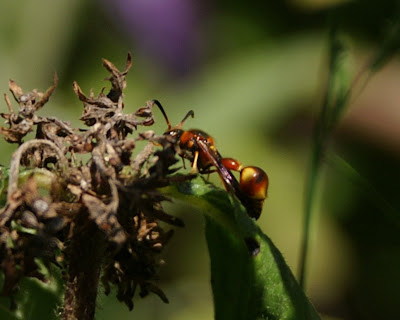
I was hanging out in the backyard, eating lunch I believe it was, when I noticed this wasp flying through. My first impression was it was something new. Then I thought, oh it's a polistes wasp. Then I was able to get close enough to see the shape of the abdomen and snap a few photos before it got annoyed and flew off. This is a mason wasp, genus Ancistrocerus, as near as I can tell. They are known as polistes mimics (fooled me for a bit). Aside from the obvious differences in body shape, though, it was the flight pattern that initially told me (trust those first impressions) this was not the usual. Instead of a slow and deliberate flight around and into the foliage (as the paper wasps do while searching for prey), this new wasp darts onto a plant then darts away, moving in more angular ways than the polistes. It is more skittish, also, and settles for just a moment before darting away. Hence the crappy photo. I'll try for more as summer progresses and also be looking for the nesting places of these gals.
No comments:
Post a Comment